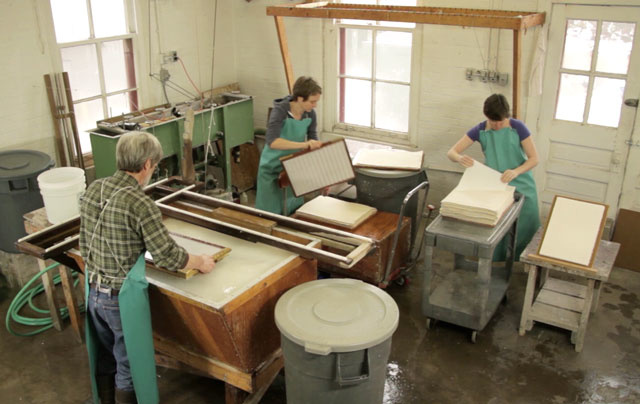A new film from the University of Iowa Center for the Book reveals important findings about historical papermaking processes. The 10-minute documentary shows UI Associate Professor Tim Barrett and his graduate student co-workers experimenting with centuries-old methods to answer current questions about paper quality, conservation, and aesthetics.
The film is intended to be of interest to Iowa public school art and history educators, home school coalitions, arts education associations, local and statewide arts organizations, public libraries, museum curators, conservators, archivists, historians, and anyone else with an interest in the important role of paper in human history.
Handmade record of human history
“Paper has been the primary substrate for the development and transmission of human culture since the year 1000,” says Barrett. “But many do not realize that prior to the invention of the paper machine around 1800, every piece of paper in the world was made by hand, one sheet at a time. In Europe, skilled artisans, working in teams of three, were able to make 2,000 or more sheets in a day or about 200 sheets in an hour.”
How did they accomplish this? And how did that rate of production impact the quality and aesthetic properties of the finished paper?

Why does some paper last longer?
Barrett’s earlier research on historical papers has led to a new understanding of how some of the longest-lasting papers were made. In a recent study, Barrett found that papers in exceptional condition from 15th century Europe contain higher levels of calcium and gelatin compared with papers from subsequent centuries. Such data can help inform the making of long-lasting modern paper. (For full research results, visit paper.lib.uiowa.edu .)
Barrett’s expertise in paper stability led the National Archives to commission his UI Center for the Book team to make special paper that now sits beneath the Charters of Freedom (The Declaration of Independence, The Bill of Rights and the Constitution) in their new encasements in Washington, D.C.
“When we make papers intended for use in the repair and conservation of rare books,” says Barrett, “giving a paper the right aesthetic properties is just as important as making it long lasting.”
Matching historical papers
Conservators require that their repair papers have a similar look and feel to historical papers. Barrett and his team have found that taking great care to make paper by hand, one sheet at a time, does not always yield a desirable match with historical papers. “The historical papers were made quickly but skillfully in large quantities as a utilitarian commodity,” Barrett notes. “In that mode of production, the paper picked up inconsistencies, imperfections, and little mistakes that were part of the essence of the old paper. We are engaged in trying to simulate the old papers, and in order to do so, we need to recreate the old production work routines.”
Barrett's work has practical application for UI Libraries staff, who repair many historical volumes. Nancy Kraft, head of preservation and conservation, says that the quality of paper used for these repairs is crucial. “We’ve learned that using modern materials can cause the book to break down. The older materials are more fragile, so the book deteriorates along the edges where old material overlaps the new material. Also, using modern material is not as aesthetically pleasing.”
“Now we work to be true to the item in hand,” says Kraft. “We choose repair paper that’s a closer match with the original material. Our goal is to maintain the look and feel of the book, flaws and all.”
Reading historical documents online
For Kraft, the importance of research like Barrett’s is especially evident when conservators repair books for digital distribution. Two years ago, the UI Libraries completed an extensive project to repair and digitize Civil War diaries. Repairs were necessary before scanning the pages to make them digitally available to the public.
Barrett teaches classes in papermaking history and technique. He also serves as director of the UI Center for the Book, a graduate program committed to the study of the book arts, and the role of paper and books in our culture—past, present, and future.
Visit the UI Center for the Book website, book.grad.uiowa.edu/.
Resources for educators
- For more on hand papermaking history and technique, see Dard Hunter’s Papermaking—History and Technique of an Ancient Craft.
- For information on papermaking with kids, see Teaching Hand Papermaking—A Classroom Guide by Gloria Zmolek Smith.